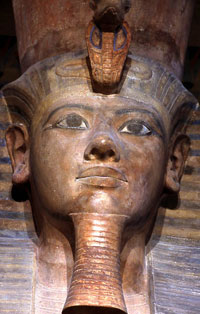WONDERFUL THINGS! THE DISCOVERY OF THE TOMB OF TUTANKHAMUN:
THE HARRY BURTON PHOTOGRAPHS
THE ANCIENT NEAR EAST IN THE TIME OF TUTANKHAMUN
The tomb of Tutankhamun is one of the most famous archaeological finds of all time. When discovered in 1922, the tomb was filled with spectacular artifacts including gold-covered chariots, elaborately carved alabaster vessels, inlaid furniture, a vast array of jewelry, and the famed gold mask. Every step of the archaeologists' painstakingly detailed work in and around the tomb was documented through photography, one of the first large-scale excavations to be so thoroughly recorded. The dramatic and artistic images clearly convey the excitement and the tension of the work, indeed, many of the photos have become as famous as the artifacts themselves. From May 23 to October 8, 2006, the Oriental Institute Museum will present an exhibit: Wonderful Things! the Discovery of the Tomb of Tutankhamun; The Harry Burton Photographs consisting of 50 of the most exciting images.
The clearance of the tomb took ten years, and in that time, photographer Harry Burton took more than fourteen-hundred large format black and white images. The photos in this exhibit document the Valley of the Kings, the initial discovery of the tomb, the dramatic moment when the excavators first glimpsed the dazzling array of artifacts, the entry to the burial chamber,  the series of shrines and coffins that protected the king, and the king's mummy, wreathed in floral collars and bedecked with gold jewelry.
the series of shrines and coffins that protected the king, and the king's mummy, wreathed in floral collars and bedecked with gold jewelry.
Harry Burton (1879-1940) was an accomplished archaeological photographer who began working in Egypt in 1910. In 1914, he joined the staff of the Egyptian Expedition of the Metropolitan Museum of Art. When Howard Carter and Lord Carnarvon discovered the tomb of Tutankhamun in 1922, Burton's services were loaned to the British team. Two sets of Burton negatives exist, one in the collection of the Metropolitan Museum of Art, the other with Howard Carter's papers now in the Griffith Institute, Oxford, UK. The prints exhibited here were loaned by the Metropolitan Museum of Art, New York.
The exhibit consists of 50 photographs with explanatory labels, wall panels that discuss the discovery of the tomb of Tutankhamun and the role of the Oriental Institute in its interpretation, the early use of photography in archaeology, the photographic career of Harry Burton, and how the photos fueled the public relations campaign of the excavators and spawned the myth of the curse of Tutankhamun. Examples of the publicity generated by the photos will also be exhibited. A brief silent film made by Burton showing activity in the Valley of the Kings will be screened in gallery kiosks. The exhibit continues through October 8, 2006.
In conjunction with the Harry Burton photos, the Oriental Institute Museum will present The Ancient Near East in the Time of Tutankhamun. This exhibit presents special labeling of the permanent galleries devoted to ancient Iraq, Turkey, Iran, Israel and Palestine, highlighting objects that are contemporary with Tutankhamun (ca. 1325 B.C.), to give the visitor a broader appreciation of the era. Egyptian objects relating to Tut and his times which have not been on exhibit—including dishes used during the funeral of the young king, sculpture, and brightly colored faience jewelry—will be on view in the Joseph and Mary Grimshaw Egyptian Gallery. The Ancient Near East in the Time of Tutankhamun will be on view through December 31, 2006.
The Oriental Institute Museum is located on the campus of The University of Chicago at 1155 East 58th Street, Chicago. Museum hours are: Tuesday through Saturday, l0:00 am-6:00 pm, Wednesday until 8:30 pm, Sunday noon to 6:00 pm, closed on Monday. Suggested donation for admission to the museum is $5.00 for adults and $2.00 for children. Telephone for program information: (773) 702-9514, or http://oi.uchicago.edu/

